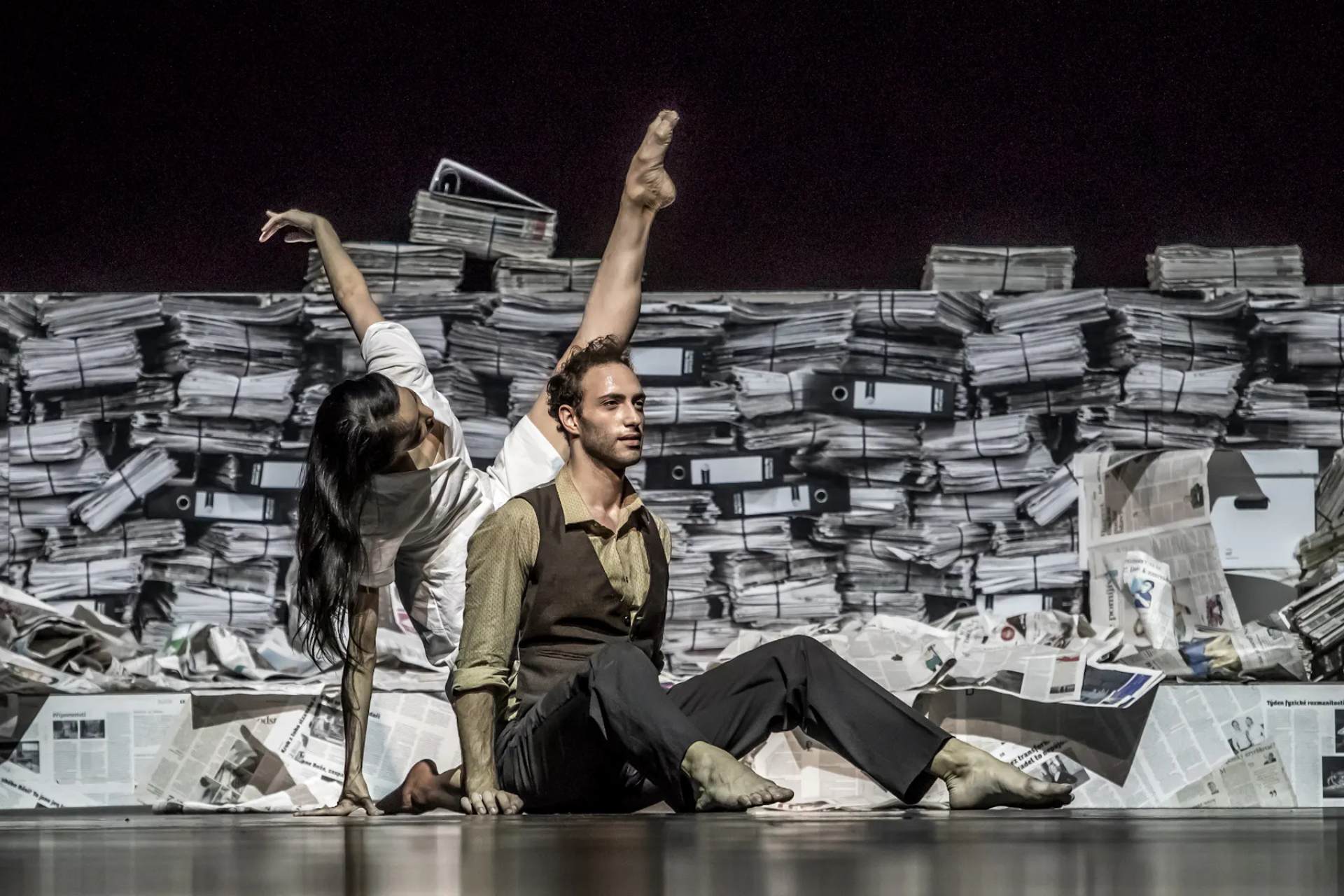Kafka The Trial
Mo | Tu | We | Th | Fr | Sa | Su |
Kafka: The Trial - Ballet
Live the story of Josef K.
Approximate running time: 1 hour 25 minutes, no intermission
In the dark of sleep, a door opens and a woman enters dressed in sheets of paper, symbolizing the fate and the trial that will rage against the protagonist…
Thus is the incipit of The Trial, a ballet by the distinguished Italian choreographer Mauro Bigonzetti, who has been loosely inspired by Franz Kafka’s eponymous 1914 literary masterpiece – its fascinating language, traumatizing plot and still valid message.
The modern production, abounding in dramatic twists and turns, reproduces the story of Josef K., who wakes up on his 30th birthday and finds beside his bed three police agents who want to arrest him for reasons that he doesn’t understand. The disoriented and incredulous protagonist is subsequently carried into a judicial machinery that drags him into a whirl of weird events.
Soloists and corps de ballet of The Czech National Ballet
Program and cast
Josef K.: Jakub Rašek, Federico Ievoli, Paul Irmatov, Matěj Šust
Nurse: Alina Nanu, Miho Ogimoto, Ayaka Fujii
Newspaper Girl: Kristýna Němečková, Kristina Kornová
Lawyer: Adam Zvonař, Marek Svobodník, Danilo Lo Monaco
Laundress: Nikola Márová, Alexandra Pera
Painter: Patrik Holeček, Paul Irmatov, Federico Ievoli, Jonáš Dolník, Danilo Lo Monaco
Commissar: Matěj Šust, Daniel Leger, Fraser Roach
Policemen: Dmytro Tenytskyy, Sami Gossart, Mathias Deneux, Robert Jerjen
Choreography: Mauro Bigonzetti
Music: Antonio Bononcini, Dietrich Buxtehude, Henryk Górecki, Carlo Gesualdo, Tarquinio Merula, Claudio Monteverdi, Modest Petrovich Mussorgsky
Sets: Carlo Cerri
Costumes: Mauro Bigonzetti
Video projection: Carlo Cerri, OOOPStudio (Alessandro Grisendi, Marco Noviello)
Assistant choreographer: Carlos Prado
Ballet master: Tereza Podařilová, Alexandre Katsapov, Jiří Kodym
Estates Theatre
The Estates Theatre today
The Estates Theatre is one of the most beautiful historical theatre buildings in Europe. It has been part of the National Theatre since 1920. The Opera, Drama and Ballet ensembles give repertory performances at the Estates Theatre.
History
The Estates Theatre is one of the most beautiful historic theatre buildings in Europe. Its construction was initiated by the enlightened aristocrat František Antonín Count Nostitz Rieneck, led by the desire to aggrandise his native city as well as the souls of its inhabitants. The construction lasted less than two years and the Theatre was opened in 1783. This project, extremely important for the Prague of the time, was in keeping with the zeitgeist of the late 18th century, a time when national theatres were being built at European courts, royal seats and cultural centres in the spirit of the Enlightenment idea that a generally accessible theatre is a moral institution demonstrating the cultural level of the nation.
The first, sporadic Czech-language performances took place in 1785. From 1812 onwards there were regular Sunday and holiday matinees. At that time, these performances became to a certain degree a political matter too. Thus arising in the difficult years following the failed revolution in 1848 was the idea of a Czech National Theatre.
By car to the National Theatre car park
To the centre (OldTown), approach on Masarykovo nábřeží (Masaryk embankment) in the direction from the Dancing House, at the crossroads in front of the National Theatre turn right to Divadelní street and then right again to Ostrovní street to the National Theatre car park. Parking costs 50 CZK/h.
From there, walk to the Estates Theatre along Národní street, then 28. října street, turn left on to Na Můstku street and right to Rytířská street.
Other nearby secure car parks:
Kotva department store (Revoluční 1/655, Prague 1), then walk along Králodvorská street to Ovocný trh.
Palladium department store (Na Poříčí 1079/3a, Prague 1), then walk along Králodvorská street to Ovocný trh, or to the Powder Gate through Celetná street to Ovocný trh.
By tram
By daytime trams Nos. 6, 9, 18 and 22 or night trams Nos. 53, 57, 58 and 59 to the stop “Národní třída”, then by foot along Národní street, then 28. října street, turn left to Na Můstku street and right to Rytířská street.
By daytime trams Nos. 5, 8, 14 and 26 or night trams Nos. 51, 54 and 56 to the stop “Náměstí Republiky”, then on foot around the Municipal House to the Powder Gate, on Celetná street to Ovocný trh.
By daytime trams Nos. 3, 9, 14, 24 or night trams Nos. 52, 54, 55, 56 and 58 to the stop “Jindřišská”, then on foot along Nekázanka / Panská streets, turn left to Na Příkopě street and then right to Havířská street (from Na Příkopě street you can also walk through the Myslbek arcade).
By metro
To the station “Můstek”, lines A and B (green and yellow), then on foot through Na Můstku street and right to Rytířská street.

 EN
EN DE
DE IT
IT FR
FR ES
ES RU
RU JP
JP RO
RO
 Seating plan
Seating plan 
